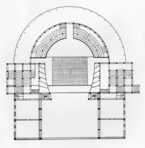ważne wydarzenia
The construction commenced in June of 1858. The design was elaborated by architect Josef Niklas, who applied a template that was used frequently at that time by architects – the Neo-Renaissance Royal Court Theatre in Dresden by Gottfried Semper, built in 1838–1841 (1869 burnt down).
Alexander Richter of Smíchov purchased the plot in 1882 for the Deutscher Theaterverein, which intended to build a regular theatre here. The last play was performed in 1885 and the theatre was torn down at the end of the February 1886 and a new building of the New German Theatre was erected here (1887–1888).
osoby
historia
František Thomé (1807–1872) succeeded Johann August Stöger (1781–1861) in 1857 as a new director of the District (Estate) Theatre. The capacity of the theatre was inconvenient at that time and addition of an upper circle was being considered already since 1834. Dissatisfaction with the theatre was reflected in the relations between Czechs and Germans as well. The Regional Committee denied the patriots' application for a permit to play Czech plays in the evenings as well. Thomé decided to solve the situation in a different manner. He started to pursue an idea of a new summer theatre in 1857 – that was related to demands for increasing the capacity of the regional theatre, which underwent a more radical reconstruction in 1859.
Thomé selected a plot behind the city walls in the lower part of a garden by a homestead called Smetánka, in the location of the present State Opera (between Vinohradská, Wilsonova and Legerova streets). This plot belonged to the family Bachhleibl. In consideration of the fact that Prague was a fortress city in this time, the structure had to be authorized by the K. K. Landes-General-Commando as well. The regional headquarters consented to the construction of a wooden theatre on 21st November of 1857. The advisory counsel of František Thomé submitted design elaborated by architect Josef Niklas (1817–1877) to the Vinohrady municipality already on 17th November. The Vinohrady municipality approved the structure on 20th November. Since Thomé did not still become the official director of the Regional Theatre, the contract with owners of the plot was signed by J. A. Stöger as well beside him. They rented the plot for construction of a roofed theatre for 15 years. Apart of a permit for organizing theatrical and musical productions, they were granted also a permit for building of a separate restaurant building in the garden. The construction commenced in June of 1858, however, it proceeded only slowly. The theatre began its theatrical season on 24th March of 1859.
F. Thomé assigned the project to professor of engineering Josef Niklas. Niklas applied the template of architects that was used frequently at that time – the Neo-Renaissance Royal Court Theatre in Dresden by Gottfried Semper, built in 1838–1841 (1869 burnt down)- for the design of the New Town Theatre. The New Town Theatre thus became a wooden replica of the first Dresden theatre. The auditorium hall was with a semicircular layout, with two tiers of boxes and circles, it was topped with a small copula with a rich arcature of semicircular windows in the tambour. The individual floors were interrupted by rectangular and semicircular windows, terraces surrounded the auditorium in the first floor level. The transition was comprised of low bays with staircases by the access to the rectangular stage. The theatre had altogether 1241 seats, standing rooms were located in the ground floor. The theatre could accommodate three, when crowded four thousand of spectators. Scenes from Czech and also German drama and opera on the ceiling were created by Carlo Brioschi, a co-owner of the one of the most famous workshops for creation of sceneries in Vienna. The theatre was roofed and lit by gas. Because it was impossible to heat it up, it was operating mostly in summer and autumn: „ The stay in the New Town Theatre, which windows are now dimmed because of the sun, is at least much more comfortable during the summer afternoon that in hot sand of an open arena. “. Apart of cold and noise from the nearby railway and restaurant, another disadvantage was the access to the theatre that led through a garden – full of mud in the season of rain.
Czech performances used to be played mostly in the afternoon from half past three, German in the evenings from seven o’clock. The New Town Theatre accommodated balls, circus performances and other attractions in the winter. The theatre was specially adjusted for balls, similarly as a ring had to be set up in the ground floor and stables were added from outside for circus performances.
After the death of F. Tomé, the heir of the arena was his underage daughter and her guardian Isidor Schmidl. The theatre gradually decayed in this time and the Vinohrady municipality constantly commanded to repair it, which was mostly not implemented. The authorities ordered stricter surveillance over the structure after the fire in the National Theatre. Disputes came about in 1881–1882, whether it was possible to use the theatre further on. A new owner of the plot, factory owner Alexander Richter of Smíchov, purchased the plot in 1882 for the Deutscher Theaterverein as it became clear later. The Association intended to build a regular theatre here – and they manage to do so in the end. The last play was performed in 1885 and the theatre with a restaurant were torn down at the end of the February 1886 and a new building of the New German Theatre was erected here (1887–1888).
Literature:
– Alfred Javorin, Pražské arény: Lidová divadla pražská v minulém století, Praha 1958, s. 53–65
autor: Markéta Svobodová
Markéta Svobodová:
informacje dodatkowe
nie wprowadzono żadnych informacji
Dodaj informacje





















